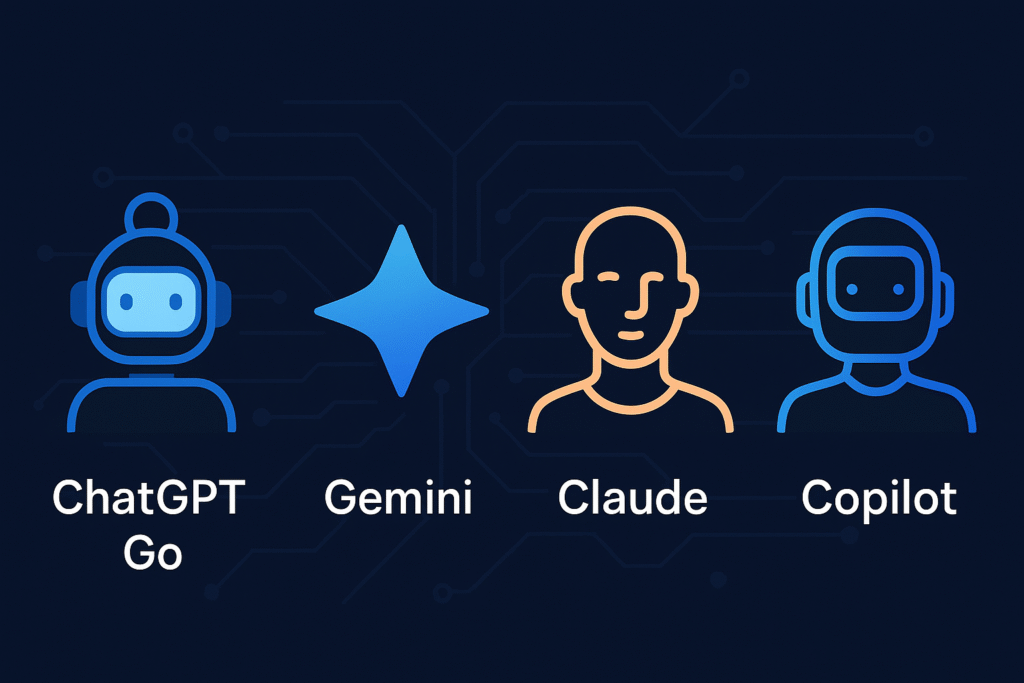🚀 The Big Announcement: OpenAI’s Game-Changing Move
On October 28, 2025, OpenAI announced something that could redefine how India interacts with artificial intelligence:
Starting November 4, 2025, ChatGPT Go — the company’s newly optimized lightweight AI model — will be free for one full year to every Indian user who signs up.
This announcement comes at a time when India has become one of the world’s fastest-growing markets for AI adoption, with millions of students, creators, and professionals turning to tools like ChatGPT, Gemini, and Copilot for productivity and learning.
The offer isn’t just a “free trial.” It’s a strategic bet — one that could give OpenAI a massive user base edge in Asia, challenge competitors, and even reshape the economics of AI itself.

💡 What Exactly Is ChatGPT Go?
ChatGPT Go is OpenAI’s lightweight, high-efficiency version of its flagship conversational model.
It’s designed to retain GPT-4-level reasoning but with:
Faster response times
Reduced computational cost
Better compatibility with mobile and low-end devices
Localized context (supports Indian English, Hindi, and regional query adaptation)
It’s a model that sits between GPT-3.5 and GPT-4-Turbo, giving users an optimal balance between power and accessibility — without draining system resources or wallets.
💡 What Exactly Is ChatGPT Go?
India has over 820 million internet users, and AI tool adoption has surged by 240% since 2023, according to Datareportal.
However, a majority of this user base remains price-sensitive.
By making ChatGPT Go free for a year, OpenAI aims to:
Dominate the entry-level AI market before competitors scale.
Train localized data from Indian usage patterns to improve model alignment.
Convert free users into long-term GPT-Plus subscribers.
Build an ecosystem moat around ChatGPT’s ecosystem — similar to how Google captured the search market early on.

🧠 The Psychology of ‘Free’: Why It Works So Well
Behavioral economics tells us that the word “free” triggers an irrationally positive response in human decision-making.
By removing the price barrier, OpenAI effectively:
Expands its brand goodwill among Indian users.
Generates a flood of feedback data to refine future releases.
Creates network lock-in — once users build workflows and trust within ChatGPT, they rarely switch.
It’s the same playbook that Google, Facebook, and Spotify used in their early stages to achieve global dominance.
🔍 ChatGPT Go vs Gemini, Claude, and Copilot — Who Wins the Round?
Let’s break down where each stands in India’s AI ecosystem:
| AI Platform | Core Strength | Weakness | Target Users |
|---|---|---|---|
| ChatGPT Go (OpenAI) | Fast, lightweight, free access | Limited tool integrations (for now) | Students, creators, startups |
| Gemini (Google) | Deep search integration | Slower creative reasoning | Professionals, researchers |
| Claude 3 (Anthropic) | Strong ethics & context depth | Limited public rollout | Enterprises, developers |
| Microsoft Copilot | MS Office synergy | Requires subscription | Corporate users |
👉 Verdict:
ChatGPT Go dominates the accessibility and versatility segment — the sweet spot that drives viral adoption.

🇮🇳 India: The New Frontier for Generative AI
India’s digital ecosystem is uniquely positioned for AI growth:
750M+ smartphone users
Record-breaking edtech expansion
Rapidly digitizing small businesses
Government support for AI literacy (through Digital India & NITI Aayog initiatives)
OpenAI’s free ChatGPT Go launch isn’t just about access — it’s about cementing AI literacy in the world’s largest youth population.
🧩 The Data Play: Why This Move Strengthens GPT Models
Every chat, query, and conversation helps improve AI accuracy through reinforcement learning.
By onboarding millions of Indian users, OpenAI can:
Train models on diverse linguistic data (Hinglish, regional dialects).
Enhance contextual understanding in multi-lingual prompts.
Gain competitive advantage in AI cultural alignment — an area where global models often struggle.
⚙️ The Business Angle — Smart or Risky?
Offering ChatGPT Go for free is a short-term revenue sacrifice for long-term market power.
If 20 million Indian users adopt ChatGPT Go and just 10% convert to paid plans post-2026, that’s an estimated $240 million annual revenue pipeline.
But this move isn’t without risk:
Server costs will spike.
Free-tier misuse (spam, low-quality queries) might increase.
Competitors may counter with local-language AI launches.
Still, the potential for data scale and brand loyalty outweighs these concerns.

🌏 What Global Analysts Are Saying
Reuters (Oct 2025): “OpenAI’s India-first strategy could shape the next billion AI users.”
BBC Tech: “This is more than a marketing move — it’s an infrastructure bet.”
AI News Today: “Expect a wave of Indian startups built entirely on ChatGPT APIs within a year.”
These insights align with a larger global narrative — AI isn’t just a tool anymore, it’s a digital infrastructure.
📈 What’s Next: The Future Beyond Free
After the free year, OpenAI may introduce:
Localized Plus Plans (₹299–₹499/month)
ChatGPT for Education partnerships with schools and colleges
Developer grants for India-based AI innovation
Integrated payment ecosystem via UPI for API and Pro services
This could create the world’s largest unified AI user base, with India as its growth engine.
🧭 Conclusion: A Masterstroke in AI Democratization
OpenAI’s decision to make ChatGPT Go free for one year in India isn’t just a product launch —
It’s a democratization moment for the world’s biggest youth-driven digital economy.
By giving away intelligence, OpenAI might just buy the future of AI itself.
